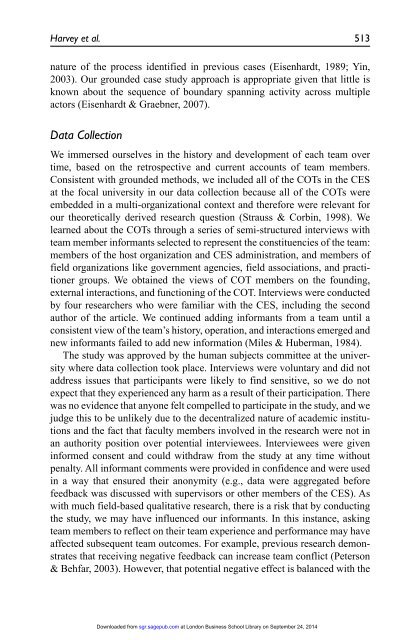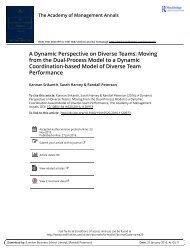The Process of Team Boundary Spanning in Multi-Organizational Contexts - Sarah Harvey, Randall S. Peterson, and N. Anand
Work teams must increasingly operate in complex environments characterized by multiple external actors beyond team and organizational boundaries. Although previous research demonstrates the importance of boundary spanning activities to team effectiveness, it reveals relatively little about the process of boundary spanning in these environments. In this article, we investigated the processes of boundary spanning across multiple external actors in 10 cross-organizational teams. We identified three sequences for reaching out to external actors: (a) moving inside-out from vertical actors inside the host organization to horizontal actors outside of the host organization, (b) moving outside-in from horizontal actors to vertical, and (c) staying-inside with vertical actors from the host organization. Our observations suggest that inside-out and outside-in sequences were more successful than simply pleasing the host organization. We build on our empirical findings to develop a process theory of how team boundary spanning activities across multiple external actors influence team effectiveness. Our research underscores the importance of a team’s interactions with actors in its external environment beyond those in an immediate supervisory role and provides insight into the dynamics of boundary spanning in multi-organizational contexts.
Work teams must increasingly operate in complex environments
characterized by multiple external actors beyond team and organizational
boundaries. Although previous research demonstrates the importance of
boundary spanning activities to team effectiveness, it reveals relatively little
about the process of boundary spanning in these environments. In this article,
we investigated the processes of boundary spanning across multiple external
actors in 10 cross-organizational teams. We identified three sequences for
reaching out to external actors: (a) moving inside-out from vertical actors inside
the host organization to horizontal actors outside of the host organization,
(b) moving outside-in from horizontal actors to vertical, and (c) staying-inside
with vertical actors from the host organization. Our observations suggest
that inside-out and outside-in sequences were more successful than simply
pleasing the host organization. We build on our empirical findings to develop
a process theory of how team boundary spanning activities across multiple
external actors influence team effectiveness. Our research underscores the
importance of a team’s interactions with actors in its external environment beyond those in an immediate supervisory role and provides insight into the
dynamics of boundary spanning in multi-organizational contexts.
You also want an ePaper? Increase the reach of your titles
YUMPU automatically turns print PDFs into web optimized ePapers that Google loves.
<strong>Harvey</strong> et al. 513<br />
nature <strong>of</strong> the process identified <strong>in</strong> previous cases (Eisenhardt, 1989; Y<strong>in</strong>,<br />
2003). Our grounded case study approach is appropriate given that little is<br />
known about the sequence <strong>of</strong> boundary spann<strong>in</strong>g activity across multiple<br />
actors (Eisenhardt & Graebner, 2007).<br />
Data Collection<br />
We immersed ourselves <strong>in</strong> the history <strong>and</strong> development <strong>of</strong> each team over<br />
time, based on the retrospective <strong>and</strong> current accounts <strong>of</strong> team members.<br />
Consistent with grounded methods, we <strong>in</strong>cluded all <strong>of</strong> the COTs <strong>in</strong> the CES<br />
at the focal university <strong>in</strong> our data collection because all <strong>of</strong> the COTs were<br />
embedded <strong>in</strong> a multi-organizational context <strong>and</strong> therefore were relevant for<br />
our theoretically derived research question (Strauss & Corb<strong>in</strong>, 1998). We<br />
learned about the COTs through a series <strong>of</strong> semi-structured <strong>in</strong>terviews with<br />
team member <strong>in</strong>formants selected to represent the constituencies <strong>of</strong> the team:<br />
members <strong>of</strong> the host organization <strong>and</strong> CES adm<strong>in</strong>istration, <strong>and</strong> members <strong>of</strong><br />
field organizations like government agencies, field associations, <strong>and</strong> practitioner<br />
groups. We obta<strong>in</strong>ed the views <strong>of</strong> COT members on the found<strong>in</strong>g,<br />
external <strong>in</strong>teractions, <strong>and</strong> function<strong>in</strong>g <strong>of</strong> the COT. Interviews were conducted<br />
by four researchers who were familiar with the CES, <strong>in</strong>clud<strong>in</strong>g the second<br />
author <strong>of</strong> the article. We cont<strong>in</strong>ued add<strong>in</strong>g <strong>in</strong>formants from a team until a<br />
consistent view <strong>of</strong> the team’s history, operation, <strong>and</strong> <strong>in</strong>teractions emerged <strong>and</strong><br />
new <strong>in</strong>formants failed to add new <strong>in</strong>formation (Miles & Huberman, 1984).<br />
<strong>The</strong> study was approved by the human subjects committee at the university<br />
where data collection took place. Interviews were voluntary <strong>and</strong> did not<br />
address issues that participants were likely to f<strong>in</strong>d sensitive, so we do not<br />
expect that they experienced any harm as a result <strong>of</strong> their participation. <strong>The</strong>re<br />
was no evidence that anyone felt compelled to participate <strong>in</strong> the study, <strong>and</strong> we<br />
judge this to be unlikely due to the decentralized nature <strong>of</strong> academic <strong>in</strong>stitutions<br />
<strong>and</strong> the fact that faculty members <strong>in</strong>volved <strong>in</strong> the research were not <strong>in</strong><br />
an authority position over potential <strong>in</strong>terviewees. Interviewees were given<br />
<strong>in</strong>formed consent <strong>and</strong> could withdraw from the study at any time without<br />
penalty. All <strong>in</strong>formant comments were provided <strong>in</strong> confidence <strong>and</strong> were used<br />
<strong>in</strong> a way that ensured their anonymity (e.g., data were aggregated before<br />
feedback was discussed with supervisors or other members <strong>of</strong> the CES). As<br />
with much field-based qualitative research, there is a risk that by conduct<strong>in</strong>g<br />
the study, we may have <strong>in</strong>fluenced our <strong>in</strong>formants. In this <strong>in</strong>stance, ask<strong>in</strong>g<br />
team members to reflect on their team experience <strong>and</strong> performance may have<br />
affected subsequent team outcomes. For example, previous research demonstrates<br />
that receiv<strong>in</strong>g negative feedback can <strong>in</strong>crease team conflict (<strong>Peterson</strong><br />
& Behfar, 2003). However, that potential negative effect is balanced with the<br />
Downloaded from sgr.sagepub.com at London Bus<strong>in</strong>ess School Library on September 24, 2014
















